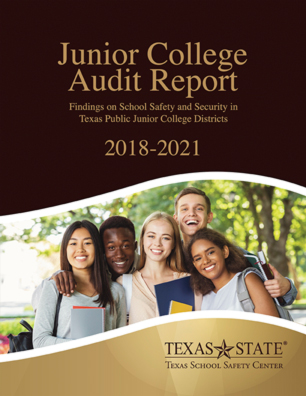TxSSC
2018-2021 Junior College Audit Report (JCAR)
Findings on School Safety and Security in Texas Public Junior College Districts

The purpose of the JCAR is to provide key results of the safety and security audits completed by Texas public junior community college districts (herein referred to as junior college districts). In accordance with procedures developed by the Texas School Safety Center (TxSSC) or an equivalent public or private entity, the Texas Education Code (TEC) requires junior college districts to complete safety and security audits of their facilities once every three years (§37.108 (4)(b)). Audits are conducted with the aim of identifying hazards, threats, and vulnerabilities that might pose a danger to life or property and/or may interfere with a safe, secure, and healthy environment that is conducive to higher education.
The TxSSC developed a model safety and security audit toolkit for junior college districts that provides guidelines showing proper audit procedures (§37.207 (1)). The audit toolkit for the 2018-2021 audit cycle included step-by-step instructions and recommendations for conducting audits, including a comprehensive audit checklist. The TxSSC captured key results of the safety and security audits completed by all Texas junior college districts. The data submitted by each junior college district were then aggregated into a statewide report for the public and the Texas State Legislature (§37.108 (4) (b)(c); (§37.207 (3)).
“The purpose of the Junior College Audit Report (JCAR) is to provide key results of the safety and security audits completed by Texas public junior college districts”
Methodology
The JCAR provides a summary of safety and security information for the reporting cycle September 1, 2018 through August 31, 2021. The report is comprised of self-reported data submitted by junior college districts in Texas. The TxSSC is authorized by the Texas Legislature to determine the method used to collect the audit results, as well as the type of data necessary for collection. Data was collected via the JCARtool, an online reporting application developed by the TxSSC.

The JCARtool consisted of four sections containing 35 single and multi-part questions. The four sections of the JCARtool included: junior college district demographics, safety and security audit information, emergency management planning, and additional safety and security information. All data is self-reported by junior college districts.
The JCARtool was made available to districts to begin reporting audit results on April 15, 2021 and officially closed for reporting on September 15, 2021. In total, all 50 junior college districts (n=50) reported audit results via the JCARtool, for a response rate of 100 percent.
Major Findings
- Forty-nine of the 50 junior college districts (98%) reported completing a safety and security audit for some or all facilities in their college districts.
- Ten of the 50 junior college districts (20%) reported that they had reported the results of their safety and security audits to their Board of Trustees at the time of submission to the TxSSC while the remaining 37 junior college districts (74%) reported their audit results are scheduled to be reported at an upcoming meeting.
- Forty-five of 49 junior college districts (92%) reported their safety and security audits were conducted using audit procedures developed by the TxSSC.
- Forty-nine of 50 junior college districts (98%) reported that they had adopted a multi-hazard emergency operation plan (EOP).
- Forty-six of 49 junior college districts (94%) with an EOP provided employees training in responding to an emergency and 49 (100%) of junior college districts with an EOP ensure district communications technology and infrastructure adequately allow for communication during an emergency.
- Forty-three of 50 junior college districts (86%) reported they had conducted a hazard analysis or similar assessment.
- Fifty junior college districts (100%) reported having key personnel responsible for emergency functions and 42 junior college districts of 50 (84%) reported having trained those key personnel in NIMS and ICS.
- Forty-six of the 50 junior college districts (92%) reported they had a behavioral threat assessment process that includes identifying concerning or prohibited behaviors and prescribes interventions.
Recommendations
The findings from the 2018-2021 audit cycle identified six key areas to serve as recommendations for improvement toward the safety and security of junior college districts in Texas. These recommendations serve to assist junior college districts to prevent/mitigate, prepare for, respond to, and recover from potential hazards, and will aide in the overarching goals of safety and emergency management—saving lives and protecting property.
- Junior college districts must continue to develop and implement an EOP.
- Junior college districts should utilize drills, such as fire drills to ensure the district community is prepared to act during the time of an emergency.
- Junior college districts should develop an active shooter policy that should be part of an overall active threat annex.
- Junior college districts should conduct a comprehensive hazard analysis.
- Junior colleges districts should develop a Continuity of Operations Plan (COOP) as part of their EOP.
- Junior college districts should develop a Communicable Disease Annex (CDA).
Refer to the full Recommendations section on page 21 for details and resources pertaining to each recommendation.